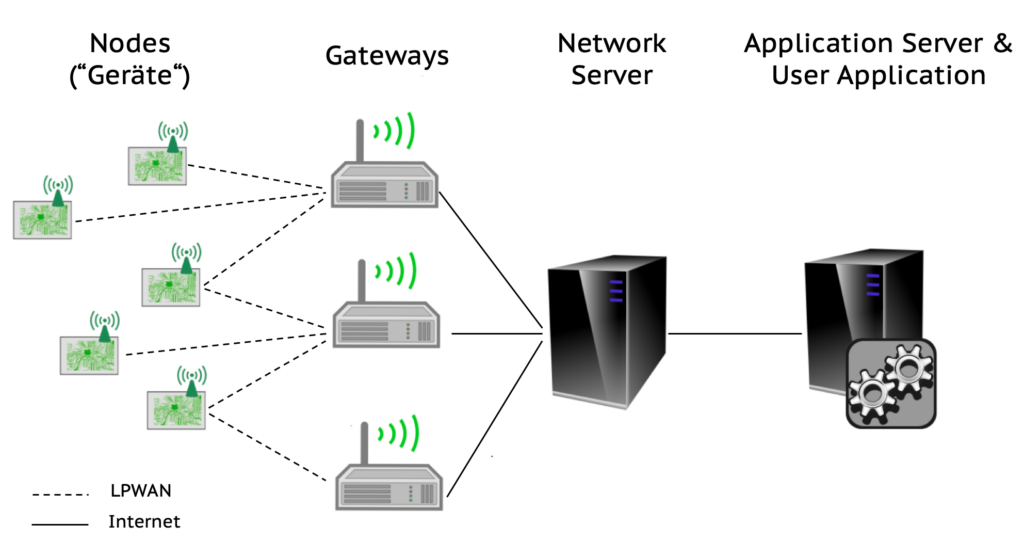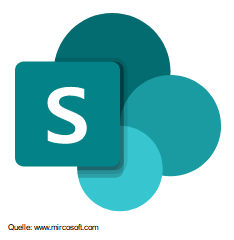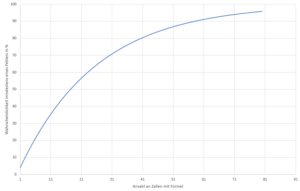Networked devices in the field already solve many problems and the potential is far from being fully exploited. In order to use the (industrial) Internet of Things – (I)IoT – a connection must be established for data transfer.
On the factory floor, this can usually be done using the existing WLAN. However, there are a large number of applications for which a connection must be established at remote and possibly frequently changing locations. It becomes even more problematic if the distributed devices require low power consumption.
Typical examples are
- Asset tracking
- Condition detection (facilities, parking lots,…)
- Water levels
- Environmental data (humidity, temperature, ice formation,…)
- Smart meter
Low energy consumption and long range are conflicting objectives that can be resolved by the third parameter in the system: The duration of the transmission.
A low data transmission rate must therefore be accepted.
This is precisely the approach taken with LPWAN. The abbreviation stands for Low Power Wide Area Network and the name is very fitting.
The characteristics of LPWAN make it a good solution for special applications
Let’s first look at the main features of the technology in order to narrow down the area of application.
A gateway can cover a radius of more than 10 km in open terrain, even in built-up areas several kilometers can be covered
The actual coverage is of course strongly influenced by the type and nature of obstacles, such as buildings, and the location of the devices and gateways. The design of the antennas also has a significant influence.
The low power requirement can enable several years of operation without changing batteries
As LPWAN devices are often used in areas without a power supply, battery life is particularly important. In addition to the basic design, the use of sleep modes in particular contributes to achieving a long runtime.
A low transmission rate must be tolerated for the application
Theoretically, a maximum of a few hundred kbit/s can be transmitted, but the actual values are usually significantly lower. This is completely sufficient for the low-frequency transmission of individual sensor data. If extensive data is generated, local evaluation and the final transmission of the result can be an effective means.
Devices are inexpensive
This is a very general statement and there may be exceptions, but the components are inexpensive and LoRaWAN in particular can be operated without transmission costs. This is a major advantage over mobile radio, where you have to pay for each device and for the amount of data transmitted.
How the grid works – A structure with four essential components
The following diagram shows an overview of the main components of the network structure. Depending on the design, further components may be added, but this is an overview first. Communication between the layers is protected by cryptographic procedures.

The devices in the field are called nodes. They contain the sensors or actuators, a microcontroller, the radio, antenna and a power supply. For many applications, a sleep mode can be used to extend the battery life. These nodes can be purchased as ready-made products or as adapters that are coupled to existing electronics. A good summary of the possibilities can be found in the TTN Wall of Fame: https://www.thethingsnetwork.org/device-repository/
The gateways receive the transmission and forward it. There must be a connection to the Internet here. The data is not processed, only the received packets are forwarded.
The network server is used to manage the network. It holds the list of registered nodes and gateways and knows the applications on the other side. This enables the correct routing of data. Identity verification is also an important security feature implemented at this level.
The data encrypted up to this point is only decrypted on the application server. It can then be used by the user application.
The nodes and possibly the gateways must be operated if no network is yet available in the region. The servers can, but do not have to, be set up independently.
There are three major providers in Germany
There are a large number of technologies and providers worldwide. We will limit ourselves here to the three largest in Germany.
LoRaWAN transmits in the EU in the license-free frequency range of 868 MHz in which garage door openers or alarm systems, for example, also communicate. To ensure that the free frequencies are not overloaded, the maximum duty cycle is limited. In addition, the transmission line is capped at 25 mW. This is an open protocol defined by the LoRa Alliance, a consortium of companies. This means that anyone can set up a local network. In addition, the community network “The Things Network” can be used, which offers good coverage in parts of Germany. The network coverage can be checked here: https://ttnmapper.org/
This protocol has the highest range and penetration of the solutions presented here.
Sigfox also transmits in the free frequency range of 868 MHz, but unlike LoRaWAN, it is a proprietary standard from the French company of the same name. The network has been expanded in large parts of Europe.
This means that a single company is responsible for network coverage and availability.
Narrow Band IoT (NB IoT) is a radio standard of LTE mobile communications and uses part of the LTE frequency space. There is therefore no sharing with unknown subscribers.
Energy consumption is typically somewhat higher than with the other solutions, but still good.
Providers in Germany, for example, are Telekom and Vodafone, which offer an almost nationwide network.
| LoRaWAN | Sigfox | NB IoT | |
| Übertragungsrate | 250 Bit/s .. 50 kBit/s | 100 .. 600 Bit/s | up to 150 kBit/s |
| Energy efficiency | very high | very high | high |
| Link Budget (corresonding to range / Reichweite / Peneration) | 154 dB | 151 dB | 150 dB |
| Frequency range | free | free | license needed |
| Network coverage in Germany | Local networks and community Network in metropolitan areas | Largely available | Largely available |
| Own network operation possible | yes | no | no |



